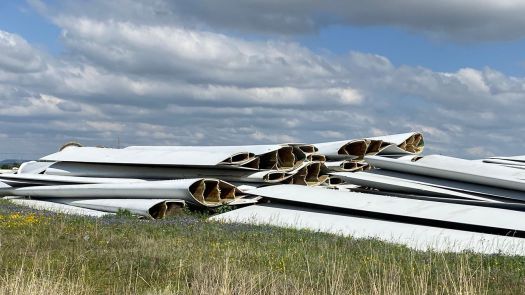WIND TURBINE AND SOLAR PANEL DISPOSAL
ALFA Energy Solutions Plasma gasification is a high-temperature process that uses an ionized gas, or plasma, to convert various types of waste materials into syngas, a mixture of hydrogen and carbon monoxide. While plasma gasification has been primarily applied to municipal solid waste and hazardous waste, it can be used to convert Wind Turbine Blades and Solar Panels into renewable materials or energy through a series of steps.
Here's a general overview of how plasma gasification can be applied to Wind Turbine and Solar Panel fiberglass blades:
- Collection and Preparation:
Wind Turbine Blades and Solar Panels waste, which may include discarded products, manufacturing scraps, or decommissioned structures, needs to be collected and prepared for the plasma gasification process. This involves the sorting and shredding the material to reduce its size and remove contaminants.
- Feedstock Injection:
The prepared Wind Turbine Blades and Solar Panels waste is then introduced into the plasma gasifier. The gasifier typically consists of a chamber where the waste material is exposed to extremely high temperatures (often exceeding 3,000 degrees Celsius) in the presence of a plasma torch and a low oxygen atmosphere, under these conditions materials pass from solid to liquid and finally in to a synthetic gas, it is important to note that at no time there is calcination of any materials and due to the lack of oxygen no dioxins can be created.
- Plasma Gasification:
The plasma torch generates an ionized gas, or plasma, by applying a high-energy electrical field to a gas (often a mixture of oxygen and steam). This intense heat breaks down the complex molecular structure of the Wind Turbine Blades and Solar Panels into simpler components.
- Syngas Production:
As the Wind Turbine and Solar Panel fiberglass blade is subjected to high temperatures, it undergoes thermochemical reactions, producing syngas. Syngas is composed of hydrogen, carbon monoxide, and trace amounts of other gases. This syngas can be used as a versatile fuel for generating heat and electricity, bio-diesel, ethanol, and or jet fuel.
- Material Recovery:
Depending on the specific requirements, it may be possible to recover certain materials from the gasification process. For example, metals or other valuable components that were present in the Wind Turbine Blades and Solar Panels waste can be separated and collected for recycling.
- Renewable Materials or Energy Generation:
The syngas produced during the plasma gasification process can be utilized for various purposes. It can be utilized directly to generate heat or used in a gas turbine to produce electricity. Alternatively, the syngas can undergo additional processing to separate and refine its components. For instance, hydrogen produced from syngas can be used as a clean fuel or feedstock for various industrial processes.
- Residue Management:
The by-products or residues from the plasma gasification process, which may include ash or other solid materials, usually less than 3% of the total input, need to be managed appropriately. Depending on the composition, they may be treated as waste or potentially utilized in other applications such as construction materials.



